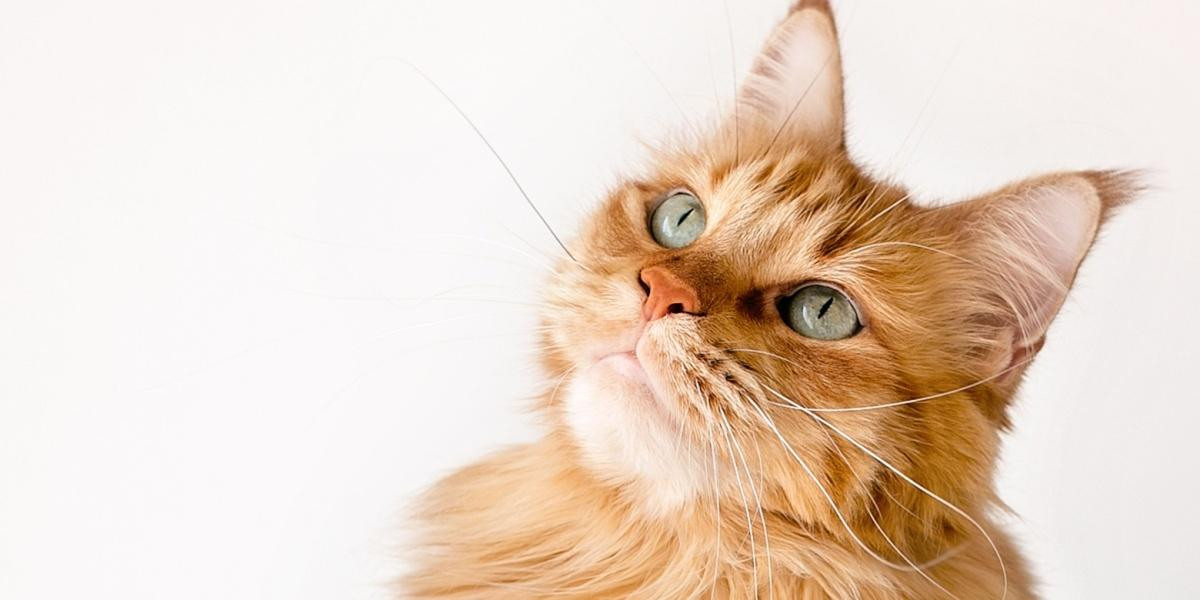 A long-haired orange cat looks up with gentle eyes
A long-haired orange cat looks up with gentle eyes
When you picture a classic feline, chances are you’re imagining a Yellow Tabby Cat. Think of beloved characters like Garfield, the lasagna-loving cartoon legend, or Morris, the famously finicky cat food connoisseur. These iconic cats, known for their striking coats and often endearing personalities, are all examples of the yellow tabby. It’s important to understand that “tabby” isn’t a breed, but rather a coat pattern – one of the most prevalent and recognizable in the cat world, seen in both domestic companions and their wild relatives.
The tabby pattern itself is characterized by distinctive stripes, and while it appears in a spectrum of colors, the yellow or orange tabby stands out as particularly striking and charming. While the term “yellow tabby cat” doesn’t denote a specific breed with predictable traits, there’s a wealth of fascinating information to uncover about these sunny felines. Let’s delve into what makes the yellow tabby cat so special and explore the captivating details of this popular coat pattern.
What Makes Yellow Tabby Cats So Endearing?
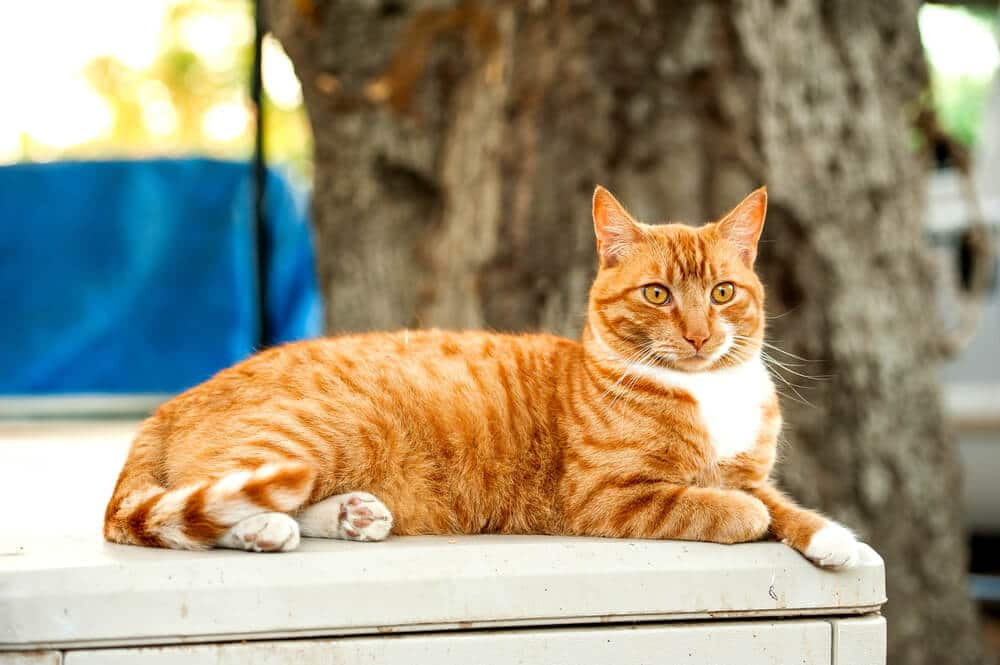 orange tabby
orange tabby
While all cats possess a unique beauty, yellow tabby cats are particularly celebrated for their warm, vibrant coats and intricate patterns. The term “tabby” refers to the diverse array of markings – stripes, spots, swirls, and ticked patterns – that adorn a cat’s fur. The extent and distribution of these patterns can vary greatly depending on the cat’s breed and individual genetic makeup. The tabby pattern might be confined to specific areas or cover the entirety of the cat’s body in a stunning display.
The tabby pattern is expressed in five primary variations:
- Mackerel
- Classic
- Spotted
- Ticked
- Patched
Although tabby cats exhibit a wide range of patterns, most share some degree of striping in their coats. In some yellow tabbies, these stripes are bold and pronounced, running clearly along the back and body, reminiscent of a tiger’s markings. In others, the striping might be more subtle, perhaps appearing mainly on the legs and tail, or presenting as softer variations of the classic stripes.
Beyond the striping, yellow tabbies, like all tabby cats, share several distinctive physical traits that make them easily identifiable. These common characteristics include:
- A prominent “M” shaped marking on the forehead
- Eyelids lined with white or dark pigment
- Pigmented paw pads and lips
- Fine, “pencil-like” lines on the face
- A lighter color on the chin and belly
- Banding patterns on the legs and tail
With a clearer picture of the defining physical traits of the yellow tabby, let’s explore each of the five tabby pattern variations in more detail to appreciate the nuances within this captivating coat type.
1. Mackerel Yellow Tabby Cat
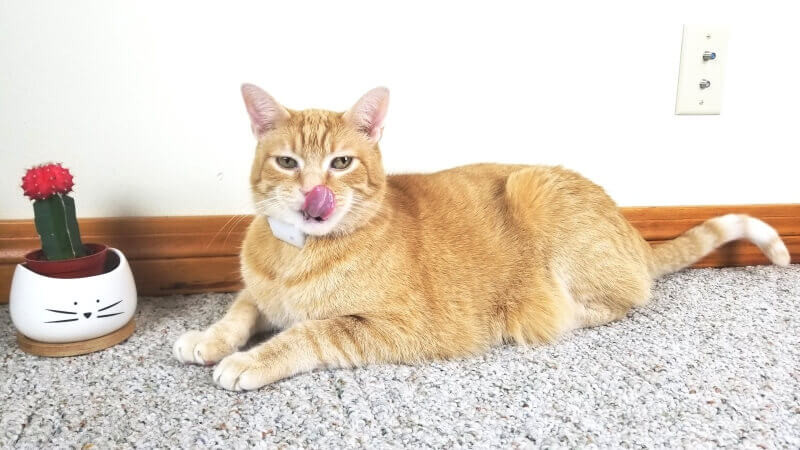 ProTrackTor.Wessie
ProTrackTor.Wessie
When you think of a “yellow tabby cat,” the mackerel pattern is likely the image that springs to mind. Often dubbed the “tiger cat,” the mackerel tabby displays narrow, parallel stripes that run vertically down the length of its body. In an ideal mackerel tabby, these stripes are evenly spaced and unbroken, creating a visually striking and symmetrical pattern.
Although they evoke the stripes of a tiger, the mackerel pattern originates from a central stripe along the cat’s spine, from which the other stripes branch out. This structure gives the pattern a resemblance to a fish skeleton, hence the name “mackerel.” This is perhaps the most recognizable and iconic tabby pattern, especially in yellow or orange cats.
2. Classic Yellow Tabby Cat
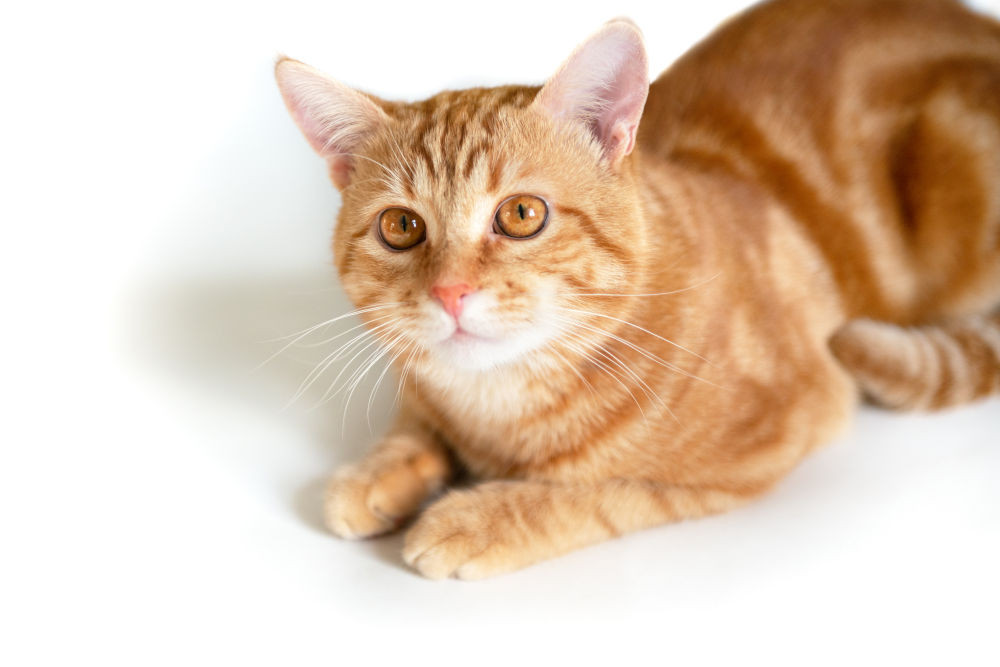 Classic orange tabby
Classic orange tabby
While the mackerel tabby might be the quintessential “tiger cat,” the classic tabby pattern holds the title of being the most common among tabby cats. Classic yellow tabbies showcase bold, swirling patterns on their flanks, often described as resembling the marbled effect seen in baked goods like cakes or breads. These swirling patterns create a mesmerizing bullseye-like design on each side of the cat, formed by a random yet beautiful arrangement of dark and light yellow or orange hues.
The classic tabby pattern is a visually rich and intricate variation, offering a softer, more rounded aesthetic compared to the linear stripes of the mackerel tabby. Its prevalence makes it a familiar and beloved sight in the world of yellow tabby cats.
3. Spotted Yellow Tabby Cat
 Spotted Tabby Cat
Spotted Tabby Cat
Tabby cats are primarily associated with stripes, but the spotted tabby pattern presents an intriguing alternative. Spotted yellow tabbies are adorned with distinct spots of varying sizes scattered across their sides. This pattern can sometimes be challenging to differentiate from the mackerel tabby, as broken mackerel stripes can sometimes appear as spots. In fact, experts still debate the precise genetic origins of the spotted tabby, questioning whether it evolved from the mackerel pattern or arose independently through different genetic pathways.
Regardless of their exact origins, spotted yellow tabby cats offer a visually engaging variation on the tabby theme. Their spots can range from small and delicate to large and bold, adding another layer of diversity to the yellow tabby family.
4. Ticked Yellow Tabby Cat
This tabby variation stands out as the most unique and can be surprisingly difficult to recognize as a tabby at first glance. Ticked yellow tabbies lack the obvious spots or stripes that characterize other tabby patterns. Instead, their tabby identity is revealed through the presence of the characteristic “M” marking on their forehead and the distinctive agouti fur. Agouti fur is defined by hairs with alternating bands of light and dark pigment, creating a speckled or “salt and pepper” appearance.
In ticked tabbies, any stripes or spots are extremely subtle, often barely visible except under strong lighting. The ticked pattern gives the coat a more uniform, blended appearance, sometimes making it appear solid in color from a distance. Breeds like the Somali and Abyssinian are frequently associated with the ticked tabby pattern, showcasing its elegant and understated beauty.
5. Bi-Color Yellow Tabby Cat
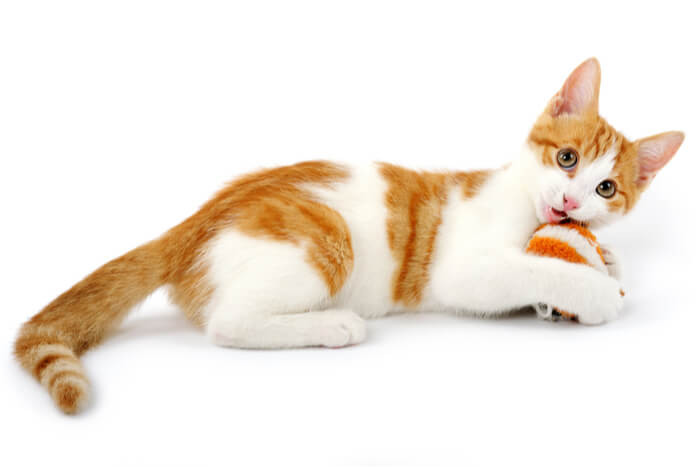 Orange and white kitten playing
Orange and white kitten playing
While traditional tabby cats often exhibit a consistent yellow tabby pattern across their entire body, bi-color yellow tabby cats present a striking contrast. These tabbies display a combination of tabby patches, which are typically darker shades of yellow or orange, alongside areas of white fur. A common example of a bi-color yellow tabby is a cat with classic yellow tabby markings complemented by distinct patches of pure white.
The bi-color pattern adds another dimension to the visual appeal of yellow tabbies, creating a charming interplay of color and pattern. The white patches can appear in various distributions, from small markings on the paws and chest to larger areas covering the belly or face, resulting in a wide range of unique and eye-catching appearances.
The Genetics Behind the Yellow Tabby
Understanding the genetics of feline coat color reveals fascinating insights into why yellow tabby cats look the way they do. In feline genetics, traits like coat color and pattern are primarily determined by genes located on the X chromosome. Female cats possess two X chromosomes (XX), while males have one X and one Y chromosome (XY).
Cats inherit a combination of genes from both parents, with the vast spectrum of cat colors stemming from just two base pigments: black and orange (or red). A kitten receives two copies of each gene, one from each parent, and each gene can be either dominant or recessive.
The gene responsible for orange coloring is dominant (O). This means a kitten only needs to inherit a single copy of the orange gene to express some degree of orange or yellow coloration in its coat.
This genetic mechanism explains the interesting phenomenon of why most yellow tabby cats are male. For a female cat to be yellow tabby, she must inherit the orange gene on both of her X chromosomes. Males, on the other hand, only need to inherit the orange gene on their single X chromosome. This genetic probability results in a significantly higher likelihood of yellow tabby cats being male, with estimates suggesting that only around 20% of yellow tabby cats are female.
Whether a kitten displays the tabby pattern at all depends on whether it inherits a dominant or recessive agouti gene. The term “agouti” describes hair shafts that exhibit alternating bands of light and dark pigment, resulting in a speckled or “salt and pepper” appearance.
Kittens that inherit at least one dominant agouti gene (A) will express a visible tabby pattern, while kittens inheriting two copies of the recessive non-agouti gene (aa) will not display the classic tabby stripes or spots and will typically be solid colored. However, even solid-colored cats can sometimes exhibit subtle tabby markings, often called “ghost striping,” if they carry two copies of the recessive non-agouti gene (aa).
Personality and Temperament of Yellow Tabby Cats
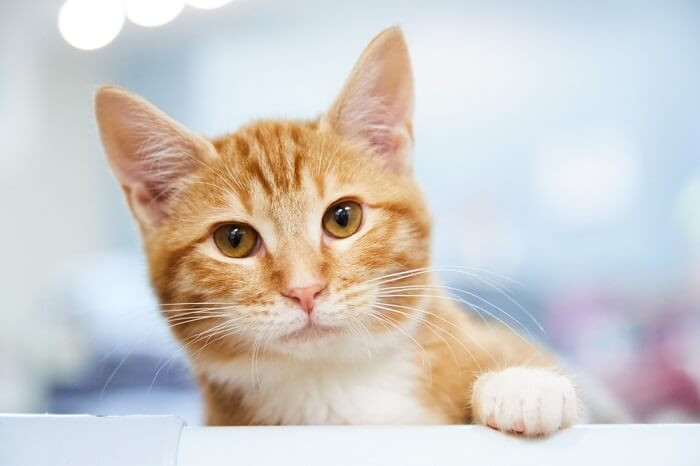
Because the yellow tabby designation refers to a coat pattern rather than a specific breed, it’s challenging to generalize about personality and temperament solely based on coat color. When considering the personality of a yellow tabby cat, the most reliable indicators are the cat’s breed (if known) and its individual upbringing and socialization.
Unfortunately, determining your cat’s breed can be difficult, especially if you adopted your feline friend from a shelter or rescued them as a stray. One way to gain insights into your cat’s genetic background is through DNA testing, such as the Basepaws cat DNA test.
Basepaws utilizes a simple saliva swab to analyze your cat’s DNA, comparing it to the world’s largest feline DNA database. The results provide a detailed report outlining the breed groups your cat belongs to and even identifying potential genetic links to wild cat species.
To provide some context regarding breeds that commonly exhibit the yellow tabby coloration, here are a few examples of cat breeds known to feature tabby patterns:
The American Curl is instantly recognizable by its uniquely curled ears, which curl backward away from the face. American Curls are born with straight ears that begin to curl within days of birth. These cats boast soft, silky coats and are known for their friendly and affectionate temperaments, often forming strong bonds with their human companions.
The Egyptian Mau is a small to medium-sized breed considered relatively rare. Egyptian Maus are renowned for being the fastest runners among domestic cats and are characterized by their playful, loyal, and highly people-oriented personalities.
The Javanese, sometimes referred to as the colorpoint longhair, is a variation of the Oriental breed. Javanese cats possess long, silky coats and are known for being quite vocal. They are energetic and playful cats who can also be very affectionate and even demanding of attention, often following their owners around the house seeking cuddles and interaction.
Also Read: 8 Gorgeous Orange Cat Breeds That Make Great Pets (With Pictures) – Note: While titled “orange,” these breeds can also exhibit yellow tones within the orange spectrum.
The Ragdoll is another colorpoint breed, celebrated for its large, muscular build and luxuriously soft, silky coat. Ragdolls are often described as relaxed and docile, yet they can also possess surprisingly bold personalities. Their gentle nature and tolerance of children make Ragdolls excellent family pets.
While generalizations about personality based solely on coat pattern should be avoided, anecdotal evidence from yellow tabby cat enthusiasts often describes their feline companions as friendly, intelligent, and patient with children and other pets in the household. However, it’s crucial to remember that individual personality is shaped by a complex interplay of genetics (breed) and environmental factors (upbringing and socialization).
12 Fun Facts About Yellow Tabbies You Might Not Know
Here are some delightful and intriguing facts about yellow tabby cats that you may not have encountered before:
- Yellow tabby cats are frequently called ginger or marmalade cats. These charming nicknames have been used for generations, adding to the affectionate image of yellow tabbies.
- The majority of yellow tabby cats are male due to their unique genetic makeup. The gene for coat color is carried on the X chromosome, leading to a higher probability of males expressing the yellow tabby trait.
- The gene for yellow coat color is dominant over most other coat colors, with the exception of white. This dominance might explain the prevalence of white as a secondary color in many bi-color yellow tabbies.
- Yellow tabby cats often develop charming dark freckles on their noses and mouths. These freckles are a common characteristic of tabbies and tend to become more prominent as the cat matures, typically appearing by the age of two.
- A yellow tabby cat’s personality is more influenced by its breed than its coat color. Yellow tabby patterns can be found across a diverse range of breeds, each with its own general personality tendencies.
- All yellow cats are technically tabbies, although not all tabbies are yellow. Many yellow tabby cats exhibit “ghost striping,” subtle tabby markings that may only be visible in bright sunlight, adding a hidden layer of pattern to their coats.
- One of the most distinctive markings shared by all tabby cats is the “M” shaped marking on the forehead. This iconic marking is a genetic inheritance from their wild ancestors, including the African wildcat, European wildcat, and Asiatic wildcat.
- While individual temperament varies greatly, National Geographic has reported a potential link between coat color and personality, suggesting that yellow tabbies may be more vocal compared to cats of other colors.
- Garfield, the world-famous, lasagna-loving cartoon cat, is perhaps the most recognizable yellow tabby cat. Debuting in 1978, Garfield holds the Guinness World Record for the most syndicated comic strip, solidifying his place in popular culture.
- Winston Churchill famously owned a yellow tabby cat named Jock, a gift for his 88th birthday. Churchill’s affection for Jock was so profound that he decreed that a yellow cat named Jock should always reside at his home, even after his passing. The current resident is Jock VI, a yellow tabby with distinctive white markings.
- Morris, the iconic mascot for 9Lives cat food, first appeared on television in 1968. The original Morris charmed audiences for a decade, and the current mascot continues his legacy under the care of Rose Ordile in Los Angeles.
- Stubbs, a ginger (yellow) cat, served as the honorary mayor of Talkeetna, Alaska, for nearly 20 years. In the absence of a human mayor, Stubbs was awarded the position as a playful effort to attract tourists, and he successfully held office until his passing.
Relevant Articles:
Original article links are already provided and relevant.
Frequently Asked Questions
Are all yellow tabby cats male?
No, but the majority of yellow tabby cats are male due to the genetic factors discussed earlier. The X-linked inheritance of the orange gene makes it statistically more likely for males to exhibit the yellow tabby coat.
Do yellow tabby cats have specific health problems?
Health predispositions are generally more breed-related than coat color-related. Therefore, any health concerns for a yellow tabby cat are more likely linked to its breed ancestry rather than its tabby pattern.
How long do yellow tabby cats typically live?
Generally, indoor house cats have an average lifespan of 15 to 20 years. Providing your yellow tabby cat with a nutritious diet, regular veterinary checkups, and a safe indoor environment can help maximize their lifespan and ensure a long and happy life.
